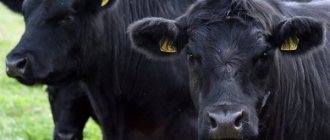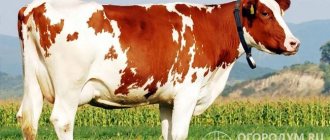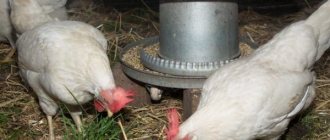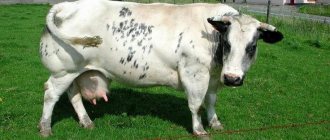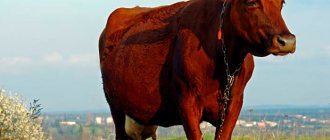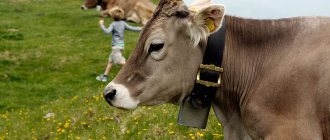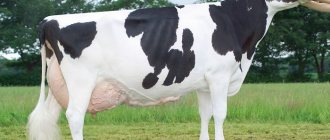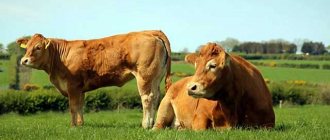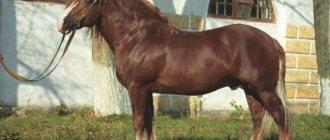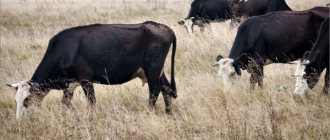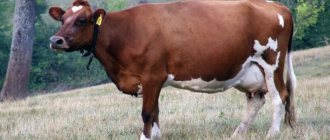Content
Although the breed is unpretentious and easily adapts to external climatic conditions, it is necessary to adhere to certain rules for its care.
Basic care
In winter, calves and adult animals are kept indoors without a leash, since they are less adapted to frost than to heat. It is not necessary to heat the barn, but for newborn calves the room temperature should be above +12 °C. Usually the cows themselves keep them warm and take care of everything they need. Animals are kept individually or in herds. If they keep a herd, then the inseminating bulls are isolated from the cows and calves.
Calves are raised in groups, in which young animals are grouped according to age:
- 6-9 months;
- 1-1.5 years;
- 1.5-2 years.
In the calf room, the floor is made of sawdust and straw; it should be deep and permanent. Provide them with room to move, they should be able to move actively in the fresh air and in the pen.
In the warm season, the herd is allowed to graze freely on a pasture, which should be located 2 km from the farm. The place must first be provided with a watering hole so that the animals do not suffer from thirst.
Main care businesses:
- regular vaccination of livestock;
- preventive examinations;
- maintaining hygiene - cows are regularly combed, udders washed before milking, and massaged;
- Hooves and horns are trimmed before free grazing begins.
Dead period
Each cow must be given a “dry” rest when she is not milked. The period lasts from 40 to 70 days. Its duration depends on the health of the cow and its nutritional status. Weak, thin animals need longer dry periods - a maximum of 70 days.
For a well-fed cow with average productivity, 40-60 days are enough. The rest from milking cannot be shortened. If a cow is constantly milked from calving to calving, this will negatively affect her reproductive function, health, and quality of milk.
Breeding
Red cows are fertile - on average there are the same number of calves per 100 females. Heifers are born for the first time (on average) at one and a half years old.
The selection of an inseminating bull is approached with great attention; it should not have hereditary defects in the body structure. If a cow has exterior defects, then a bull without genetic defects must be selected to pair with her.
This will reduce the risk of poor-quality calves being born.
Nutrition
Although animals are unpretentious to food, to increase milk yield, they must be fed with high-quality feed.
In the summer, lush, fresh vegetation is enough for them; in the winter, the cattle are fed hay with the addition of mixed feed. It’s also good to add root vegetables, silage and concentrated ingredients to the menu.
You cannot feed animals:
- low-quality products - rotten, rotten, spoiled;
- cold, including drinking cold water.
Diseases
Red cows have high immunity; they rarely suffer from leukemia and respiratory diseases. They must be vaccinated against foot and mouth disease, anthrax and emphysematous carbuncle (emkara).
Prevention against parasites that settle in the digestive system or lungs is carried out annually. In the summer, animals are checked for the presence of ticks and gadfly larvae, which develop inside the skin, and bites are treated.
Another disease of females of the breed is mastitis, which develops during machine milking. To avoid this, you should gently massage the udder after each milking.
Reviews from Kalmyk cattle owners
Darsen Elyanov, village. Khar Tolga
My great-grandfather kept herds of Kalmyk cows before the revolution. Then he was dispossessed, but he retained his love for cattle throughout his life. So it was passed down from generation to generation. Now I myself only keep 20 heads. The leased land is only 100 hectares and I cannot afford more livestock. I have cows on pasture all year round. There, only a light barn without doors was built as a shelter from the wind. In case of a cold winter, I buy additional hay. After all, I only have 20 cows, and not 3 thousand, like my great-grandfather. And I can’t afford to lose even one. I don't milk them. Milk is not very popular in our country and there is no point in milking a beef cow.
Vasily Orlov, pos. Ilyich's path
I got a Kalmyk cow two years ago as an addition to my dairy cows. I decided to provide my family with delicious beef. Compared to dairy cows, the Kalmyk cow is a little wild. And after calving, it’s better not to visit her at all. I didn’t believe the stories that they would even attack their owners because of a calf. I kept it together with dairy products. And when she calved, she didn’t let me into the barn at all. Raised it on its horns. I barely drove her into a separate pen. I took into account the mistake and made a separate pen for her. In the absence of calves, the animal is quite calm.
Animal breeding
Breeding cows is quite a profitable business if you know how to do it correctly. To start breeding Ayrshires, you need to follow the following instructions:
- Learn the rules for keeping cows in summer and winter, as well as feeding rules. If you plan to sell milk or meat, you need to find preliminary distribution channels for your products: markets, retail outlets, dairies and supermarkets.
- Make a business plan for your future business. This should include all possible risks and accounting for business costs.
- Register an enterprise (for example, individual entrepreneur), rent or buy a plot on which you will raise cows, and obtain permission from Rospotrebnadzor.
- Build a room and equip it with everything you need.
- Buy young stock. Choose animals according to what you will be doing (tips on choosing a calf can be found below). To sell milk, it would be advisable to purchase more females.
Farmers prefer purebred breeding (when a female is crossed with a male of the same breed). This approach to selection allows one to avoid genetic defects in both parents and future offspring. Often, livestock breeders experiment and cross breed bulls of the Ayrshire breed with females of the Red Steppe, Simmental and Holstein breeds, which entails positive results (increased milk production).
Breeding cows is a profitable business
What is a bull line?
The fundamental direction of selection in today's dairy farming is the breeding of animals taking into account certain lines. A bull line is a category of males of the same breed that share a common, exclusive ancestor. There are several types of lines. The genealogical category is distinguished by individuals that appeared from one ancestor. The genealogical line covers individuals of various pedigrees, and the factory line is created through careful selection, as a result of which the unique productive properties are preserved.
The process of breeding bulls along lines is as follows:
- Before you start breeding along lines, identify the improving bull by assessing the quality of his offspring.
- From all the offspring, identify outstanding sires and select the ancestor who will start the line.
- Send the ancestor for reproduction, and at the next stage, reproduce his offspring to obtain material for subsequent selection.
- From the sons of the ancestor, select the best (based on qualities), then select one bull to continue the family.
- Continue the same with the next generation, evaluating the grandchildren of the first selected sire (ancestor).
Lines can exist as long as the valuable qualities of the bred animals are preserved (usually they begin to fade away at the 4-5th generation). The choice of the ancestor and subsequent main individuals must be careful. In dairy farming, outstanding females from the best families can be used to improve milk quality.
Ayrshire bull
Calf selection
Before calculating calf body and weight indices, it is necessary to check your livestock conditions. To avoid problems with the productivity of cows later, study the rules of care and feeding of Ayrshires, and then purchase a cow
When purchasing a calf of this breed, you need to pay attention to the following indicators:
Live mass. Each breed has its own standards. That is why it is necessary to study the instructions for grading cattle in advance. For example, if a female Ayrshire weighs less than 250 kilograms per year, it is worth considering that perhaps the animal is sick or was born frail and weak.
Calf development. Includes height intensity and overall physique. In young animals, the strength of the constitution and defects in physique are first assessed (from 10 months).
Pedigree
Pay attention to the mother's productivity and the male's line. These indicators can tell a lot about the calf's future success.
Avoid inbreeding.
The main rule is to purchase a calf from a bona fide farm with a good reputation. Only there will you be provided with real data about the calf’s pedigree and its origin. The chance of finding a healthy animal that will delight you with its performance for a long time in such a place is much greater than when buying an animal from unknown and unscrupulous farms.
Ayrshire calves must be purchased from a farm with a good reputation
Breeding methods
Kalmyk cattle are used as genetic material to improve the breed qualities of other cows, as well as to develop new breeds for meat productivity. Within a breed, cows improve themselves as a result of selection. The main qualities are higher early maturity, as well as an increase in average daily weight gain.
There are two types of Kalmyk breed: early ripening with a light body weight and late ripening with a high percentage of meat yield and a large body. Cows reach sexual maturity at 18 months and can reproduce the herd for quite a long time, more than 10 years. A cow can be used for reproduction when it reaches a live weight of 300 kg.
The mating process occurs naturally, with a high percentage of fertilization. Calving does not cause any difficulties. Newborn calves have a live weight of 20-22 kg. The main disadvantage of the Kalmyk breed of cows is their very strong concern for their offspring, as a result of which the cows do not allow humans near the young animals.
These cows do not need constant attention; they themselves gain weight during drives, which can reach tens of kilometers. But a prerequisite is to rest for about 6 hours.
These cows don't need constant attention.
It is necessary that light penetrates well into the room where cattle are kept. It is better to install large windows. Good stall ventilation is also important. It is not necessary to insulate the building, only if the temperature drops below 40 degrees. Under average conditions, simply laying straw is sufficient. The barn must be constantly cleaned and the water clean.
Kalmyk bulls and cows are resistant to diseases, but require vaccinations. When barn cleanliness rules are not followed, animals may be susceptible to helminth infection.
In summer, animals are not fed compound feed, which can be quite expensive, since they only have enough food to consume while grazing. In winter, concentrated feed is introduced.
Animals should never run out of water; it should be topped up 4-5 times a day. If the animal weighs less than 250 kg of water, about 40 liters are required; if the animal weighs less than 250 kg, 50 liters are required. If you weigh more than 350 kg, use 60 liters of water per day. There should be as much water as needed.
Even though animals of this breed can get food out from under the snow in winter, an additive in the form of:
- Tubers;
- Vegetables;
- Seine;
- Silo.
When the cow reaches the age of 1.5 years, she is completely ready to reproduce and bear offspring. She is capable of giving birth to calves up to 15 years of age. There is a condition that a bull can be allowed near a cow only when the latter reaches a live weight of 300 kg. The mother does not allow anyone near the newborn calves, so the baby grows up being close to her.
Note! For grazing, the Kalmyk breed of cows needs a large space with various grasses growing. She can stay on one pasture for no more than a week, after which the animals need to be moved to a new place. Cows are not picky about feed on the field
Even dry grass suits them
Cows are not picky about feed on the field. Even dry grass suits them.
Strict natural selection during the breeding process led to excellent development of the gastrointestinal tract. Representatives of this breed easily digest rough bulk feed. This indicates unpretentious feeding conditions without compromising effective body weight gain.
In the cold season, cattle are overgrown with a thick undercoat, thanks to which they can withstand temperatures dropping to -35 -450C. Keeping them on an open range is possible with temperature changes from -40 to 35.
High life expectancy and a long period of sexual maturity allow females to bear healthy offspring for 15 years. The calf survival rate is recorded at 95%.
Weight loss in winter varies on average from 70 to 100 kg. If there are good autumn pastures, individuals go into winter with a high content of fatty tissue (up to 70 kg), which allows them to easily endure the cold season. Animals go out to spring pastures in a state of average fatness.
High pasture utilization rates make breeding Kalmyk cows economically viable and profitable. They find plant food even on desert steppe lands.
Features of feeding
Cows of this breed are able to eat even feeds that are unsuitable for cattle, including semi-shrub plants. One of the best properties of the breed, highly valued by farmers, is the ability of livestock to fatten on grass alone, without the need for concentrated feed. The farmer's main expense at this time of year is the purchase of salt for the cows.
Important! Kalmyk cattle are very demanding of water.
When there is a lack of water, animals stop eating and, consequently, become thin. The daily need for water depends on the body weight of the animal:
- up to 250 kg – at least 40 liters of water;
- up to 350 kg – at least 50 l;
- over 350 - at least 60 liters.
It is rational to introduce such restrictions when there is a lack of water in pastures. If there is enough water, animals should drink plenty.
Classification of cattle breeds[ | ]
Based on various characteristics, cattle breeds are divided into several groups. There are 3 classifications of livestock breeds:
- craniological,
- economic,
- geographical.
Craniological classification
Craniological classification is based on differences in the structure of the skull. The following types of cattle are distinguished:
- narrow-minded - Dutch, Kholmogory, gray Ukrainian, Yaroslavl, Tagil, red steppe and other breeds;
- forehead - Simmental and all breeds derived from it;
- short-horned - Swiss, Jersey, Kostroma, Lebedinskaya, etc.;
- short-headed - Tyrolean, Hereford, red Gorbatov, Kazakh white-headed, etc.;
- straight-horned - Kalmyk breed, Mongolian cattle;
- polled - all hornless breeds of Northern Europe.
Economic classification
| Productivity direction | Description | Origin | Breed name |
| Specialized dairy breeds | Cattle milk has been used by humanity for food for more than six thousand years. Today, the share of cow's milk in the total amount of dairy products consumed is 95%. | Ayrshire | |
| brown Swiss | |||
| Guernsey | |||
| Holstein | |||
| Jersey | |||
| red danish | |||
| red Baltic | |||
| red steppe | |||
| Tagil | |||
| Kholmogory | |||
| black-and-white | |||
| Yaroslavl | |||
| Specialized meat breeds | Beef cow breeds have been selected for the last 300 years. The goal of these selections is to create animals that can most efficiently convert feed into high-quality beef. Beef cows also produce dairy products, but their quantity is maintained at a level that only ensures feeding of young animals. This is due to the fact that the physiological processes associated with the formation of milk and meat are completely different. Traditionally, the most common and popular beef cattle were British breeds created in the 18th-19th centuries. It was these animals that became the basis for meat production in America, Australia, some regions of Asia, Eastern and Southern Africa, continental Europe, the territory of the former USSR and Japan. | British origin | Aberdeen Angus |
| beefbuild | |||
| Galloway | |||
| Hereford | |||
| Devonian | |||
| dexter | |||
| Lincoln | |||
| Longhorn | |||
| Sussex | |||
| Highland | |||
| Shorthorn | |||
| French origin | limousine | ||
| men-anjou | |||
| Salerskaya | |||
| light Aquitaine | |||
| Charolais | |||
| Italian origin | Kian | ||
| Markjan | |||
| Piedmode | |||
| Romagnola | |||
| Central Asian origin | Kazakh white-headed | ||
| Kazakh (Kyrgyz) | |||
| Kalmyk | |||
| gray Ukrainian | |||
| Breeds of hybrid origin | Afrikaner | ||
| beefmaster | |||
| boran | |||
| barzona | |||
| Bosmara | |||
| brahman | |||
| brangus | |||
| skated | |||
| Santa Gertrude | |||
| shabrai (chabrai) | |||
| Volyn meat | |||
| Combined livestock breeds | Meat and dairy breeds | Alatau | |
| Bestuzhevskaya | |||
| Brown Carpathian | |||
| Caucasian brown | |||
| Kostroma | |||
| red Gorbatovskaya | |||
| red Tambov | |||
| Lebedinskaya | |||
| Montbéliarde | |||
| Simmental | |||
| blue cow | |||
| Suksunskaya | |||
| Sychevskaya | |||
| brown Swiss | |||
| Yurinskaya | |||
| Yakut |
Geographical classification
According to geographical classification, livestock breeds are distinguished:
- lowland - mainly dairy;
- mountain - Tyrolean, Swiss;
- steppe - Ukrainian steppe, red steppe, etc.
Every breed has a range
Origin
It is known that the Kalmyk cow appeared on the territory of the Russian Federation 400 years ago. It is believed that Kalmyk nomads brought it from the lower reaches of the Volga, as well as from Mongolia. Since these tribes led a nomadic lifestyle, the cows also became accustomed to it and became quite unpretentious to their living conditions. Further development of this breed was carried out through natural selection. In the 19th century, this type of cow was well described, but no selective measures were applied to it. This link will tell you about the Simmental breed of cows.
Kalmyk cows appeared on the territory of the Russian Federation back in the 19th century.
Systematic selection work with this breed was carried out from 1920 to 1928, as a result of which more than a thousand heads of hardy cattle with enhanced immunity and high muscle mass were obtained. In the future, breeders worked only on strengthening these parameters. To date, they have bred several subspecies of cows adapted to different climatic conditions.
What advantages and disadvantages does it have?
The breed belongs to the meat breed and is highly valued by breeders for its high-quality, fine-fiber meat with a small amount of fat. What other advantages do individuals have?
The average weight of Kalmyk bulls is 600-1000 kg
- The average weight of bulls of the Kalmyk breed is 600-1000 kg, cows – 500-550 kg. When properly maintained and fed, the meat has excellent taste.
- Cows of the Kalmyk breed grow quickly. At birth, the calf weighs 25 kg, and gains an average of 1.5 kg every day. At 18 months, bull calves already weigh at least 350 kg.
- The cows of this breed have milk, although not a lot - 600-1500 kg per year, depending on nutrition. However, the amount is fully compensated by fat content. This product has 4.5-6.2% fat content and, of course, is expensive!
- Cows can produce healthy offspring for 15 years! At the same time, the survival rate of young animals does not fall below 95%. Calving is easy, without significant problems.
- With significant weight loss in winter or after calving, cows and bulls quickly recover in the spring and summer.
The Kalmyk breed has one drawback, and it can pose a serious problem for the breeder. Cows behave very aggressively after calving. They are caring towards the cub, but the breeder poses a threat to them during this period. Therefore, they feed their offspring themselves. There can be no talk of excommunication. So the care of the offspring always falls entirely on the young mother. This both simplifies the breeder’s work and to some extent complicates it, since one must behave carefully and warily in the stall.
Probable diseases
Kalmyk cows are distinguished by high immunity. Therefore, if they have all the required vaccinations, disease outbreaks among them are rare. The main diseases that occur in representatives of this species include:
- leukemia;
- Lentospirosis;
- actiminosis
Failure to comply with hygiene standards can result in helminthiasis. Therefore, it is necessary to monitor the condition of each individual in the herd. When the first symptoms of the disease appear, it is important to show the affected animal to a veterinarian. Once the diagnosis is confirmed, treatment will be prescribed. During the period of therapy, the sick cow should be kept separate from the herd in a stall and on a walk. This will protect other animals from infection.
What to feed
Cows of the Kazakh white-headed breed are also unpretentious in food, however, only a balanced diet allows for maximum weight gain.
The diet of these animals can be divided into 2 periods:
- summer, when animals receive maximum nutrients from the pasture;
- winter, when the animal needs a large amount of nutrients.
Summer grazing on a pasture
During this period of the year, feeding cows is not difficult. They require free walking in the pasture, where they themselves will find everything they need for food. However, the pasture needs to be changed regularly, for example once a month. At the same time, you need to choose a productive one so that there is at least 8 centners of greenery on one hectare.
Did you know? Cows of the Kazakh white-headed breed are considered one of the hardiest, as they can cover up to 30 km in a day under the merciless scorching sun.
If free walking of livestock on the pasture is not possible, then a feeder with hay is installed in the pen. Grains, beets and silage are given as additional feeding. Animals also need to be given additional vitamin supplements and bone meal. The diet of breeding bulls mostly contains grains and legumes.
Feeding diet in winter
In winter, cattle need an additional source of nutrients. The winter diet of the Kazakh Whitehead consists of 60% roughage (straw) and 40% concentrated feed.
The animals are given compound feed, hay, and silage. Cereals, root vegetables and legumes are also included in the diet. Don’t forget about vitamins and other nutritional elements; additional supplements made from bone meal, phosphates, chalk and calcium are added to the diet.
Water and table salt
A cow, like any other animal, needs water. Since cows are quite large animals, they therefore require a large amount of fluid. The animal drinks 10 times a day, and at one time they are able to drink up to 15 liters of water. Accordingly, on average, one animal needs about 150 liters. Of these, only 30–35 liters are needed to maintain vital processes in the body.
Another integral component in the diet of cows is table salt. An animal cannot obtain this element from plant foods, so it is given as additional food. Salt is involved in the synthesis of hydrochloric acid, which is formed in the stomach.
Sodium is involved in the functioning of nerve endings and also maintains the health of muscle and bone tissue. In addition, sodium affects the percentage of fat in milk. Sodium chloride helps maintain salt balance in the body. It participates in the metabolic process and has antibacterial properties.
However, table salt also has its disadvantages. For example, its excess causes dysfunction of the genital organs, the formation of cysts, and a decrease in the amount of milk
That is why it is very important to monitor the daily allowance that is given to cows
The daily intake of table salt can vary depending on the weight of the animal, the amount of milk the animal produces, and the time of year. For normal functioning of the cow’s body, she is given NaCl at the rate of 5 g for every 100 kg of live weight and 4 g for each liter of milk.
Salt can be given in bulk, but in this case there is a high probability of overdose. However, the use of salt slimes allows you to provide the necessary amount of NaCl. They can be hung near the feeder, where the animal cannot trample the licks.
Detailed description of the breed
Horned animals are easily recognized by the color of their fur - it is colored red or red-brown and differs in the intensity of its tone. Red-brown spots and white markings on the forehead, belly, udder and limbs are acceptable. In adult bulls of the breed, the upper and lower parts of the body are painted in a darker color.
Their body itself is somewhat angular and elongated. The belly is voluminous, which is typical for all representatives of dairy breeds, since their ribs are widely spaced. Unlike other breeds, in the red steppe representative it does not sag even during the period of bearing a calf.
The head is small, narrow, one might say graceful, the nose is dark-colored. The neck is long with many folds. The horns are light gray and point forward. This poses a threat to livestock and humans. During a fight, a cow or a bull can tear open the enemy and cause him serious injuries. Therefore, it is recommended to dehorn calves if possible.
The skin is smooth and elastic. If a cow loses weight, the skin will not sag. And weight loss and gain is a common occurrence for them, depending on weather conditions. The skeleton is quite light and fragile, the muscles are rather poorly developed.
The udder of cows is small, round, well developed, with cylindrical teats. It is convenient to milk cows by hand, as it is glandular, that is, soft to the touch. A fairly common sight is an irregularly shaped udder. When milk accumulates, the udder stretches greatly, so that after milking its volume decreases several times, and small folds form on the udder. The nipples are quite convenient for both manual and machine milking, the length of the front ones is about 6.5 cm, and the rear ones -5.7 cm.
External indicators
The Red Steppe is a fairly recognizable breed; its distinctive exterior features include:
- withers at a height of 125-132 cm;
- chest girth reaches 190 cm;
- oblique length can reach up to 160 cm;
- chest width according to measurements is from 37 to 42 cm.
- the body is angular and slightly elongated, the muscles are weak;
the neck is narrow, tendonous with pronounced folds, the head is slightly elongated; the metacarpus in girth is 17-19 cm. The legs are strong and straight, the chest is narrow; the udder may be unevenly developed and of medium size.
Breeding rules
The rare breed is hardy, unpretentious and resistant to weather factors. Blue animals claim to be widely bred. After mating with any bull, a cow produces blue offspring. The difficulty is that there are almost no unique animals left. It is very difficult to purchase calves with blue coat color. But federal subsidies will be a bonus for farmers who decide to take such a step. The Latvian government is interested in preserving cows, which are the country's national symbol. The European Union also helps livestock breeders; a special program has been developed to save the endangered species.
Description and characteristics of Auliekol breed cattle, maintenance rulesRead
Advantages and disadvantages
Kalmyk cows are different:
- endurance;
- high adaptation to harsh climates, including severe heat and frost;
- high taste of meat;
- precocity;
- rapid gain of muscle and fat mass combined with relatively low losses during the cold season;
- unpretentiousness in nutrition;
- simplicity of content;
- rapid growth of the livestock due to the high percentage of calf survival;
- high fat content of milk, which is valued in the market;
- strong immune system.
The main disadvantage of the breed is considered to be aggressiveness. This quality is especially evident if a person tries to get closer to the calf. As a result, in the first months of the baby’s life, caring for him falls entirely on the mother’s shoulders. On the one hand, this reduces the farmer’s work in caring for
On the other hand, extreme caution must be exercised when entering a barn or being near a herd of calves.
Weaknesses also include the non-marketable type of meat. An inexperienced buyer may confuse it with old cow meat. However, the appearance pays off with a unique taste that beef lovers will appreciate.
History of appearance
The exact origin of the breed is unknown. Given the high degree of adaptation to heat and frost, the presence of wild cows among the ancestors is assumed. Indian cattle and Asian aurochs are also added to the family tree. However, there is no evidence to support this hypothesis.
Representatives of this breed were first discovered in the steppes of Kazakhstan in the 18th century. The attention of breeders was attracted by strong immunity, endurance, resistance to pathologies, independence from adverse factors and ease of care. And the next 150 years were aimed at improving these qualities.
As a result, by the middle of the 20th century, livestock breeders had several thousand animals at their disposal, whose performance had been improved. This made it possible to significantly expand their habitat area. Depending on the zonal distribution, Kazakh, North Caucasian, Siberian and Lower Volga cows are distinguished. Work on crossing Kalmyk cows continues.
Breed standard
Kalmyk cattle have a very unique exterior characteristic.
These are short, massive animals with developed muscles and good fat deposition. The main stock is red with a white head and chest. The head is crowned with sharp horns pointing upward. Characteristics of the Kalmyk breed
| Place and time of withdrawal | the breed was formed starting from the 17th century in the southern regions of Russia |
| Color and exterior features | Large animals with a strong build, good fat deposits and brown coloration |
| Live weight | for cows 450-550 kg and up to a ton for Kalmyk bulls |
| Measurements | at the withers - 130 cm in cows and up to 140 cm in bulls, the chest is deep - up to 70 cm and wide - 40-45 cm. |
| Productivity direction | meat, are characterized by rapid weight gain. |
| Milk yield | small - just over 1000 liters, rarely receive a milk yield of over 2000 kg. Fat content over 4%. |
| Record figures | the highest milk yield was obtained from the Ulan-Alyk cow of 4800 liters with a fat content of 4.7% |
Young animals and bulls
Kalmyk cattle are characterized by a relative late maturation compared to meat breeds. Calves do not have an average daily weight gain of more than 800-900 grams. The breed is characterized by a high survival rate of young animals of 95-99%. Calving occurs easily, complications are extremely rare.
Birth weight is 20 kg for heifers and 30 kg for bulls. Taking into account the average growth rate, by 8 months we get 180 and 240 kg, respectively. The reproductive period begins in heifers at 18 months, when they gain 300-320 kg.
Bulls of the Kalmyk breed are responsive to improved conditions and intensity of fattening. When the diet is strengthened, they gain increased weight and by 18 months the bulls begin to weigh over 500 kg. Mature bulls rarely exceed a ton. They show a high slaughter yield - up to 60%, the meat is of high quality.
Cows
The dairy herd of Kalmyk cattle is represented by strong animals of red color with white spots on the face and limbs. The characteristics of cows are as follows:
- narrow head with a concave crest and upward-pointing horns;
- the neck is short, covered with folds of medium thickness;
- the body is wide – up to 42 cm in the chest;
- short animals - no more than 130 cm at the withers;
- the weight of cows is 450-550 kg, animals up to 600 kg are rare;
- muscles are developed;
- milk yield is small - up to 1500 kg;
- high fat content – up to 6%;
- milk is rich in protein - up to 4.3%;
- good reproductive ability.
